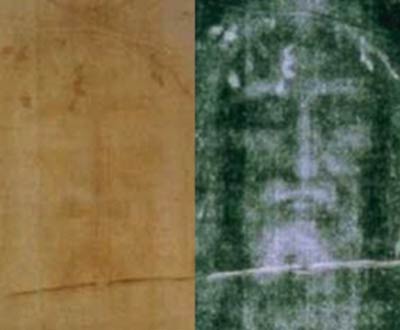
A truly gorgeous Easter has just passed, one that meant more to me than previous Easters have, for reasons I’ll not go into here. As is customary, Holy Week television included lots of programming on the subject, much of it speculative “scientific” debunking of various religious traditions, some inspired by the best-selling heretical drivel of the novelist Dan Brown. The tone of this stuff is so consistent that I was truly surprised by a History Channel program about the Shroud of Turin.
Since the 14th century, the Shroud has been venerated as the cloth in which the body of Jesus was wrapped when he was buried. It has various stains and burn marks, the latter from a fire in 1532. When it was photographed in 1898, the photographer discovered that faint markings on the Shroud when viewed in the negative revealed the face and body of a man who had apparently been severely beaten and crucified.
It has been the subject of tremendous controversy, with claims that it is a fake almost from the beginning of its 13th-century display. Scientific testing over the years has been inconclusive.
The Shroud has always fascinated me, and the more I looked into it the more I believed it is genuine. What forger would create an object in anticipation of the invention of photography 600 years hence? Without photography, the Shroud’s most remarkable aspect is not visible.
The television program last week dealt generally with the Shroud’s history, but the main point was an effort by computer graphics technicians to employ the mysterious image it contains in hope of creating a three-dimensional view of the man it depicts — Jesus to those who believe, as I do.
 |
|
The Shroud shown as a standard and negative photo. |
A regular aspect of Shroud research over the years is that many scientists and technicians who begin as skeptics end up believing that the relic is genuine. So it was with the technicians at Studio Macbeth in New York, who put together the three-dimensional image. They began looking at the project as a job to do; by the time they were done their eyes welled with tears as they described it. The image itself was, to me, very moving. Using only information provided by the Shroud itself, it shows a man who was brutally scourged before being crucified. The wound in the side described in scripture is there in all its terrible detail.
As inspiring as the program was, it was also frightening.
Science is not a system of morality. It is a tool, a set of tools, really, that unlock the previously impossible. A hammer can be used to build things or to destroy them. Through science we learned to split the atom; there is no better example of how science gives us no guidance in how to use what we have learned.
How long will it be before a Shroud researcher decides that it might be possible to extract DNA from the stains it bears? How long will it be before we hear of the parsing of the genome of, perhaps, Jesus?
Would this be a good thing? Could it be?
I don’t think so.
Faith requires us to believe that which we cannot prove. It is a virtue, and a necessary one. Imagine a world in which our lives and our decisions all required proof. Our relationships, our hopes, our aspirations would all change markedly or disappear altogether.
But faith isn’t an easy thing. We always look for ways to make it require less of us. We always seek proof which, fortunately, isn’t always available. At least since the time of Aristotle, scientists and philosophers have sought proof of the existence of a divine being, a creator, God. They have failed.
Or they have tried to prove the opposite. They have failed there, too, unless you think that a particle of infinite mass and zero size suddenly exploded and whammo, we have the universe; to me that’s unconvincing.
The old saying is that when all you have is a hammer, everything looks like a nail. When all you have is science, everything is a problem to be solved. A few years ago I wrote someplace that if you dissect the cat you’ll learn a great deal about cats but you won’t have one anymore.
Don’t get me wrong. The tools with which science and things scientific have equipped us have made possible the long and wonderful story of human progress. But science does not take us everywhere we need to go. Science will never give us the works of Shakespeare. It will never eliminate our need for faith, nor will it make faith easier.
It is a tool, and its use, seems to me, must be tempered by something else.
I wonder sometimes if our science has maybe gotten ahead of that something else. The idea isn’t new, and it could be argued that if I were a caveman I might be saying, “I don’t know about that fire stuff — looks pretty dangerous to me.” Fair enough. Though here, millennia later, that fire stuff still is pretty dangerous.
Science tells us what we can do, not whether we should do it. If you don’t believe me, ask the cat.
Join the Conversation
Pingback: Twitter Trackbacks for The View from Mudsock Heights: Faith and Science are Separate Things - OFB.biz: Open for Business: via [ofb.biz] on Topsy.com
d; margin-top: 3px;”>